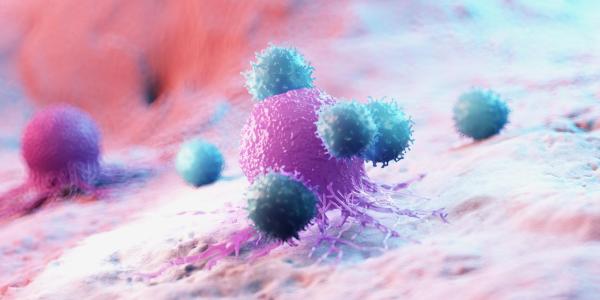Cancerous growths in the liver of a mouse. (Credit:��Imaging/tissue extraction by Anthony B. Eason; lab of Dirk Dittmer, University of North Carolina Lineberger Comprehensive Cancer Center. Mice maintained by UNC Animal Studies Core; staining by UNC Animal Histopathology Core)
��
Scientists at CU ɫ������ and Princeton University have, for the first time, employed a tool often used in geology to detect the atomic fingerprints of cancer.
In a case of medicine meets earth science, the researchers discovered that cancer cells may be made from a different assortment of hydrogen atoms than healthy tissue. The findings could give doctors new strategies for studying how cancer grows and spreads—and may even, one day, lead to new ways to spot cancer early on in the body.��
The team, led by CU ɫ������ geochemist Ashley Maloney, in the Proceedings of the National Academy of Sciences.
“This study adds a whole new layer to medicine, giving us the chance to look at cancer at the atomic level,” said Maloney, a research associate in the Department of Geological Sciences.
She explained that in nature, hydrogen comes in two main flavors, or isotopes. Some hydrogen atoms, called deuterium, are a little heavier, while others, usually just known as hydrogen, are a little lighter. On Earth, hydrogen atoms outnumber deuterium atoms by a ratio of about 6,420 to one.��For decades, scientists from a number of fields have turned to the natural distribution of these atoms to reveal clues about the history of our planet. Climate scientists, for example, examine the hydrogen atoms trapped in the ice on Antarctica to infer how hot or cool Earth was hundreds of thousands of years ago.
In the new study, Maloney and her colleagues wondered: Could those same tiny atoms provide hints about the lives of complex biological organisms?
To find out, the team grew cultures of yeast and mouse liver cells in the lab, then analyzed their hydrogen atoms. The team found that cells that are growing really fast, such as cancer cells, contain a much different ratio of hydrogen versus deuterium atoms. Think of it like cancer leaving a fingerprint on the doorknob of a crime scene.��
The research is still in its early stages, and the team isn’t sure how this signal might appear, or not, in the bodies of real cancer patients. But the potential could be big, said Sebastian Kopf, a co-author of the study and an assistant professor in geological sciences.��
“Your chances of survival are so much higher if you catch cancer early on,” Kopf said. “If this isotopic signal is strong enough that you could detect it through something like a blood test, that could give you an important hint that something is off.”
The metabolism of cancer
The study centers around a concept that has intrigued cancer researchers for years: metabolism.
Under normal conditions, the cells of organisms like yeast and animals generate energy through a process called respiration, in which they take in oxygen and release carbon dioxide. But that’s not the only way to get a sugar high. Colonies of baker’s yeast (Saccharomyces cerevisiae), for example, can produce energy via fermentation, in which organisms break down sugars without help from oxygen and produce alcohol. It’s the same process that gives you beer.
“In humans, if an athlete performs beyond their aerobic limit, their muscles will also start fermenting, which doesn’t use oxygen,” Kopf said. “That gives you a quick energy boost.”
As it turns out, many cancer cells also fuel their growth through a similar get-rich-quick strategy.��
Scientists have long searched for more ways to track these metabolic changes in cancer cells. Maloney, who led the new study as a Harry Hess Postdoctoral Fellow at Princeton, and her advisor Xinning Zhang decided to follow hydrogen.
Inside the cell
Today, Maloney manages CU ɫ������’s Earth Systems Stable Isotope Lab, one of more than 20 Core Facilities on campus. As a graduate student, she explored hydrogen atoms in algae from tropical islands. Her current work was inspired by an unlikely source: her father, a dermatologist.
“He takes skin cancer cells off people all the time,” Maloney said. “I wondered how the metabolism of those cells might be different from the cells growing next to them.”
To understand that question, it helps to know how hydrogen winds up in cells in the first place. In some cases, those atoms come from a hard-to-pronounce, but critically important, enzyme known as nicotinamide adenine dinucleotide phosphate (NADPH). Among its many roles in cells, NADPH collects hydrogen atoms then passes them to other molecules in the process of making fatty acids, an important building block for life.��
NADPH, however, doesn’t always draw from the same pool of hydrogen. Previous and focusing on bacteria suggested that, depending on what other enzymes in a cell are doing, NADPH may sometimes use different hydrogen isotopes more or less often.
Which raised the question: If cancer rewires a cell’s metabolism, could it also alter how NADPH gets its hydrogen, ultimately altering the atomic makeup of a cell?
Window into cancer
To begin to find out, the researchers set up jars filled with flourishing colonies of yeast in labs at Princeton and CU ɫ������. Separately, biologists at Princeton conducted an experiment with colonies of healthy and cancerous mouse liver cells. The researchers then pulled the fatty acids from the cells and used a machine called a mass spectrometer to identify the ratio of hydrogen atoms within.��
“When we started the study, I thought, ‘Ooh, we have a chance to see something cool,” Maloney said. “It ended up creating a huge signal, which I didn’t expect.”
Fermenting yeast cells, the kind that resemble cancer, contained roughly 50 percent fewer deuterium atoms on average than the normal yeast cells, a startling change. Cancerous cells exhibited a similar but not quite as strong shortage in deuterium.
Zhang, the study’s senior author and an assistant professor of geosciences at Princeton, is hopeful the research could one day help families around the world.
“Cancer, and other illnesses, are unfortunately a huge theme in many people’s lives. Seeing Ashley’s data was special, profound moment,” Zhang said. “It meant that a tool used to track planetary health might also be applied to track health and disease in lifeforms, hopefully one day in humans. Growing up in a family challenged by cancer, I hope to see this area expand.”




